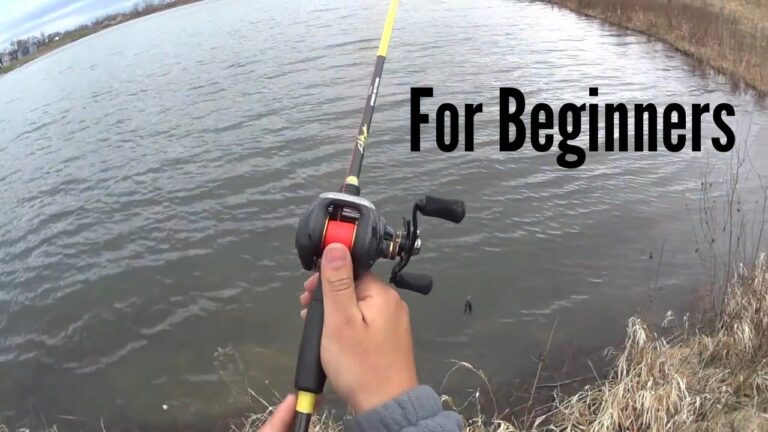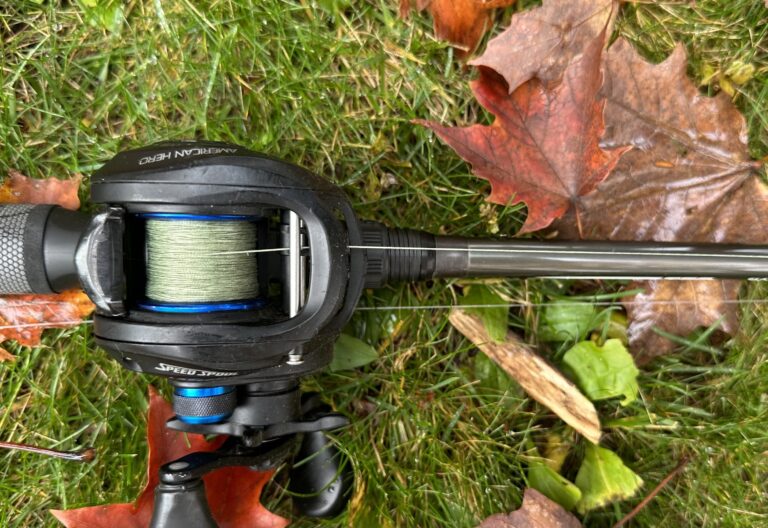Baitcasting reels work by using a revolving spool to release and retrieve fishing line efficiently. These reels are commonly used in freshwater and saltwater fishing and are designed for casting accuracy and control.
The spool is mounted perpendicular to the rod and is rotated by the angler’s thumb pressure on a thumb bar or spool tension dial. As the line is released from the spool, the angler uses their thumb to control the speed and distance of the cast.
Baitcasting reels also have braking systems that help prevent backlash and offer adjustable drag settings for reeling in fish. They are preferred by many experienced anglers for their precision and versatility in various fishing conditions.

Credit: fishrazr.com
Understanding The Basics Of Baitcasting Reels
Baitcasting reels are popular among anglers because of their versatility and precision. Whether you’re a beginner or an experienced angler, understanding the basics of baitcasting reels is essential for achieving successful fishing results. In this section, we’ll explore what a baitcasting reel is, its advantages and disadvantages, as well as its key components.
Let’s dive in!
What Is A Baitcasting Reel?
- A baitcasting reel is a type of fishing reel commonly used for casting heavier lures and baits over long distances.
- It is designed with a spool that revolves as the line is released, allowing for greater control and accuracy in casting.
- Unlike spinning reels, baitcasting reels are mounted on top of the fishing rod, providing a direct line of sight for accurate casting.
Advantages And Disadvantages Of Using A Baitcasting Reel:
- Advantages:
- Greater control: Baitcasting reels offer more control over casting distance, accuracy, and lure placement.
- Power and strength: These reels are built to handle heavier lines and tackle, making them ideal for targeting larger fish species.
- Versatility: Baitcasting reels can be used in various fishing techniques, including flipping, pitching, and trolling.
- Sensitivity: The direct reel-to-rod connection allows anglers to feel even the slightest nibble or bite, enhancing the overall fishing experience.
- Disadvantages:
- Learning curve: Baitcasting reels require some practice to master casting techniques and prevent backlash or bird’s nests.
- Backlash potential: Improper casting technique can result in backlash, where the spool spins faster than the line, causing tangles.
- Cost: Baitcasting reels are often more expensive than spinning reels, primarily due to their advanced design and precision engineering.
- Line capacity: Compared to spinning reels, baitcasting reels have relatively lower line capacities, limiting their suitability for some fishing applications.
Components Of A Baitcasting Reel:
A baitcasting reel consists of several key components that work together to ensure smooth operation and optimal performance:
- Spool:
- The spool holds the fishing line and rotates during casting and retrieval.
- It is typically made of lightweight, durable materials like aluminum or graphite.
- Varying spool sizes and capacities allow anglers to match their reel to specific fishing needs.
- Handle:
- The handle is used to retrieve the fishing line.
- It can be positioned on the left or right side of the reel, depending on the angler’s preference.
- Handles are often ergonomically designed for comfortable and efficient reeling.
- Drag system:
- The drag system controls the resistance of the fishing line when a fish pulls against it.
- It ensures that the line doesn’t break under the pressure of a strong fish.
- Baitcasting reels typically have adjustable drag systems to suit different fishing conditions and target fish.
- Braking system:
- Baitcasting reels employ a braking system to prevent backlash and ensure smooth casting.
- Brakes can be centrifugal or magnetic and provide varying levels of control over spool rotation during casting.
- Gear ratio:
- The gear ratio determines the number of times the spool rotates with each turn of the handle.
- A higher gear ratio indicates faster line retrieval, while a lower gear ratio provides increased torque for battling larger fish.
Understanding the basics of baitcasting reels sets you on the path to becoming a more effective angler. Whether you’re looking to cast with precision, target bigger fish, or try out different fishing techniques, a baitcasting reel could be a valuable addition to your gear.
Mastering The Techniques Of Baitcasting Reels
Baitcasting reels are an essential tool for anglers who want to take their fishing skills to the next level. However, mastering the techniques of baitcasting reels can be challenging for beginners. In this section, we will discuss the key techniques that will help you become a proficient baitcaster.
So, let’s dive into it!
Proper Grip And Stance
To cast with a baitcasting reel effectively, it is crucial to have a proper grip and stance. Here are a few key points to keep in mind:
- Hold the reel correctly: Place your thumb on the spool’s release button and ensure a firm grip on the handle.
- Maintain a balanced stance: Stand with your feet shoulder-width apart for stability while casting.
Casting Techniques For Baitcasting Reels
Proper casting techniques play a vital role in baitcasting success. Let’s explore some popular casting techniques:
- Overhead cast: This is the most common and basic casting technique where you bring the rod over your shoulder and cast the line forward.
- Sidearm cast: This technique is useful when you need a low and accurate cast. Hold the rod parallel to the water’s surface and cast it with a sidearm motion.
- Roll cast: Ideal for fishing in tight spaces, the roll cast involves using the wrist to roll the line and lure onto the water’s surface.
Adjusting The Braking System
Baitcasting reels come with a braking system that helps control the spool’s rotation during casting. Here’s what you need to know about adjusting the braking system:
- Start with the manufacturer’s recommended settings and make adjustments based on the weight of the lure and your casting style.
- Gradually increase or decrease the braking force to prevent backlashes and achieve longer and more accurate casts.
Controlling Backlashes
Backlashes can be frustrating, but with the right techniques, you can minimize them. Consider these tips:
- Thumb control: Place your thumb lightly on the spool during the cast to control the line’s release.
- Practice your timing: Develop a smooth and consistent motion while casting to minimize the chances of backlashes.
Common Causes Of Backlashes
Understanding the causes of backlashes can help prevent them. Here are a few factors to consider:
- Improper braking system settings
- Insufficient thumb control during the cast
- Casting into the wind without adjusting the brake properly
How To Prevent And Correct Backlashes
Preventing and correcting backlashes is essential to maintain a smooth fishing experience. Take note of these useful tips:
- Start with shorter casts and gradually work your way up to longer distances.
- When a backlash occurs, carefully untangle the line by pulling it out gently or using your thumb.
Choosing The Right Line And Lure For Baitcasting Reels
Selecting the appropriate line and lure is crucial for successful baitcasting. Consider the following:
- Line selection: Opt for a high-quality, low memory line that matches the targeted species and fishing conditions.
- Lure choice: Match the lure’s weight and size to the rod and reel specifications for optimal casting performance.
Mastering the techniques of baitcasting reels requires practice and patience. Implementing these techniques will ensure a more enjoyable and productive fishing experience. So, grab your baitcasting reel, hit the water, and have some unforgettable angling adventures!
Maintenance And Troubleshooting Tips For Baitcasting Reels
Baitcasting reels are essential tools for any fishing enthusiast. These reels are known for their accuracy, control, and durability. However, to ensure their optimal performance, regular maintenance and troubleshooting are necessary. In this section, we will discuss some key tips for maintaining and troubleshooting baitcasting reels.
Cleaning And Lubricating The Reel
Keeping your baitcasting reel clean and well-lubricated is crucial for its smooth operation. Here are some important steps to follow:
- Remove the reel handle and spool, and clean them with a mild detergent and warm water.
- Use a soft toothbrush or a cotton swab to clean hard-to-reach areas and remove any debris or dirt buildup.
- After cleaning, thoroughly dry the reel to prevent any corrosion.
- Apply a small amount of reel oil to key parts such as the gears, bail, and handle knobs.
Checking For Wear And Tear
Regularly inspecting your baitcasting reel for wear and tear can help prevent any major issues during your fishing trips. Here’s what you need to check:
- Examine the line guide and make sure it is intact and not warped or bent. If damaged, consider replacing it.
- Inspect the gears for any signs of excessive wear, such as chipped or missing teeth. Replace the gears if necessary.
- Check the drag system to ensure it is working smoothly and adjust it if needed.
- Look for any loose or damaged screws or other parts that may affect the reel’s performance.
Proper Storage Of Baitcasting Reels
Proper storage is essential to protect your baitcasting reel and extend its lifespan. Consider the following tips:
- Always clean and dry the reel before storing it to prevent corrosion.
- Place the reel in a soft cloth or reel case to protect it from scratches and dust.
- Store the reel in a cool and dry place, away from direct sunlight or extreme temperature changes.
- Avoid leaving the reel in a damp or humid environment, as this may cause damage.
Troubleshooting Common Issues With Baitcasting Reels
Even with proper maintenance, baitcasting reels can experience some common issues. Here are a few troubleshooting tips:
Reel Not Casting Smoothly
- Check if the spool tension knob is properly adjusted. Adjust it to find the right balance between control and distance.
- Make sure the line is properly spooled on the reel and not tangled or twisted.
- Clean and lubricate the reel, as mentioned earlier, to ensure smooth operation.
Line Twist And Tangles
- Ensure that the line is properly spooled onto the reel, with proper tension to avoid twists and tangles.
- Slowly reel in the line to minimize loops and twists.
- If the line is already twisted, consider removing it and replacing it with a fresh one.
Drag Problems
- Adjust the drag settings according to the size and weight of the fish you are targeting.
- Check if the drag washers are clean and not worn out, replacing them if necessary.
- Lubricate the drag system to ensure smooth operation.
By following these maintenance and troubleshooting tips, you can keep your baitcasting reel in top condition and enjoy a smooth and successful fishing experience. Remember to regularly inspect, clean, lubricate, and store your reel properly to ensure its longevity. Happy fishing!
Conclusion
To summarize, baitcasting reels are a vital tool for anglers looking to elevate their fishing game. Understanding how these reels work is essential for successful casting and retrieval. With their intricate design and advanced features, baitcasting reels offer unparalleled precision and control.
The spool’s rotation, the drag system, and the braking mechanism all work together to provide smooth and accurate line release, ensuring efficient and effective fishing. By mastering the proper technique and adjusting settings to match specific fishing conditions, anglers can optimize their baitcasting reel’s performance.
Whether you’re a beginner or an experienced angler, taking the time to learn and practice with a baitcasting reel can greatly enhance your fishing experience. So, gather your gear, hit the water, and enjoy the exciting world of baitcasting reels.
Happy fishing!




